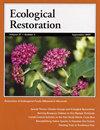Demography, Time to First Flowering and Longevity of 14 Temperate Forest Herbaceous Species, Iowa, USA
IF 1.1
4区 环境科学与生态学
Q2 ECOLOGY
引用次数: 0
Abstract
ABSTRACT The ability of temperate forest herbaceous species to recover from anthropogenic disturbance and to colonize new secondary woods is limited by both seed shortage (lack of dispersal) and suitable safe sites (sites where seedling establishment is possible). In this study, which originated in 1998–99, I added seeds of 14 species, including six phylogenetically related pairs classified as common or restricted in distribution, to both occupied and unoccupied upland forest sites. I recorded emergence the first year and followed yearly survival for an additional five years. Adding seeds resulted in flowering individuals for 12 of the 14 species and an additional species established by vegetative spread. I concluded that dispersal, rather than safe sites, was most limiting. Species with restricted distributions, which also have larger seeds than related common species, had higher survivorship over five years. Minimum longevity ranged from 8–18 years, suggesting that once on site, long-term persistence is possible. A practical implication of these results is that limited funding and other resources can be focused on seed addition techniques, particularly for larger-seeded species. Because the mean age to first flowering was six years, a second practical implication is that the traditional monitoring protocol of following plants through to reproduction as a measure of restoration success may be difficult for many long-lived species. Using “citizen scientists” to monitor may help make long-term monitoring more feasible beyond the limited time frame of grant funding.美国爱荷华州 14 种温带森林草本植物的数量、初花时间和寿命
摘要 温带森林草本物种从人为干扰中恢复并在新的次生林中定居的能力受到种子短缺(缺乏传播)和合适的安全地点(有可能建立幼苗的地点)的限制。在这项始于 1998-99 年的研究中,我在有人居住和无人居住的高地森林地点添加了 14 个物种的种子,其中包括 6 个系统发育相关的物种对,它们被归类为常见或限制分布物种。我记录了第一年的萌发情况,并在其后的五年中跟踪了每年的存活情况。加入种子后,14 个物种中有 12 个个体开花,还有一个物种通过无性繁殖建立起来。我得出的结论是,最主要的限制因素是传播,而不是安全的地点。分布受限的物种,其种子也比相关的常见物种大,五年内的存活率较高。最短存活期为 8 至 18 年,这表明一旦进入安全地点,长期存活是可能的。这些结果的实际意义在于,可以将有限的资金和其他资源集中用于种子添加技术,尤其是对于种子较大的物种。由于植物首次开花的平均年龄为六年,因此第二个实际意义是,传统的监测方法是跟踪植物的繁殖情况,以此来衡量恢复的成功与否,但这对许多寿命较长的物种来说可能比较困难。利用 "公民科学家 "进行监测可能有助于使长期监测在有限的资助时间框架之外更加可行。
本文章由计算机程序翻译,如有差异,请以英文原文为准。
求助全文
约1分钟内获得全文
求助全文
来源期刊

Ecological Restoration
Environmental Science-Nature and Landscape Conservation
CiteScore
1.70
自引率
12.50%
发文量
24
期刊介绍:
Ecological Restoration is a forum for people advancing the science and practice of restoration ecology. It features the technical and biological aspects of restoring landscapes, as well as collaborations between restorationists and the design professions, land-use policy, the role of education, and more. This quarterly publication includes peer-reviewed science articles, perspectives and notes, book reviews, abstracts of restoration ecology progress published elsewhere, and announcements of scientific and professional meetings.
 求助内容:
求助内容: 应助结果提醒方式:
应助结果提醒方式:


